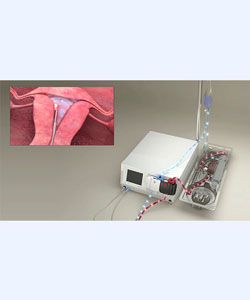Symphion System Overview Animation
The Symphion Operative Hysteroscopy System is designed to remove intrauterine tissues such as fibroids and polyps. The Symphion system as several components:
- a controller with integrated fluid management
- a disposable fluid management accessory
- a 6.3 millimeter OD endoscope
- and a disposable 3.6 millimeter OD bipolar hysteroscopic tissue removal device.
The Symphion endoscope is inserted through the cervix into the uterine cavity, then the bipolar tissue removal device is inserted through the endoscope working channel and its resecting window is positioned against the targeted fibroid.
Suction through the tissue removal device pulls the tissue into the resecting window and a reciprocating electrode within the opening resects tissue using bipolar plasma technology.
If bleeding occurs during resection, a bipolar coagulation feature on the resecting device can be used to reduce operative bleeding, which allows the user to maintain clear visualization through the continuous flow recirculating fluid management system.
Direct intrauterine pressure monitoring prevents uterine cavity collapse and helps maintain uniform intrauterine cavity distension throughout the procedure.
The Symphion recirculating fluid management system uses only one 3-liter saline bag as distension media which filters and recirculates the used fluid during the procedure.
The system provides a maximum of 2.5 liters of saline for recirculation and volumetrically limits fluid absorption.
During filtration, resected tissue is separated and collected into a tissue catch container.
Next, a molecular filter removes viruses, bacteria and blood cellular components before the fluid is returned to the original saline bag.
The tissue catch container can be detached from the system and sent for pathology evaluation.
Due to the minimal thermal damage caused by the bipolar plasma tissue, resection the resected tissue chips collected inside the container are viable for histopathology evaluation.

